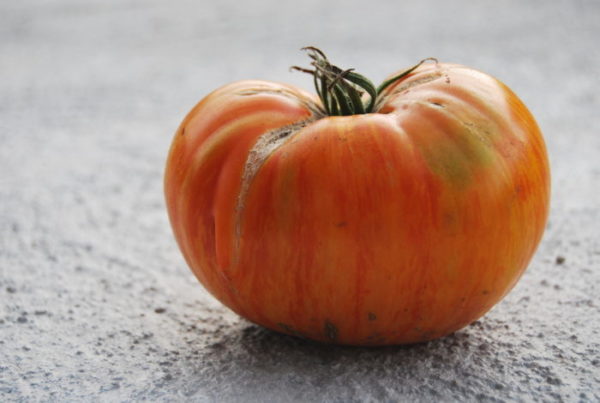
Tomatoes - one of the most common vegetables, which is used both for creating salads and for canning. Therefore, many owners of gardens and cottages seek to get their own harvest, which will fully satisfy their needs. And if there is a greenhouse on the site, then you need to choose a special variety that makes the most of the created conditions. These are the striped Georgia tomatoes.
The Georgia striped tomato variety reaches maximum productivity in greenhouse conditions, and delights owners with beautiful fruits. Reviews about the taste of berries are the most positive, because of which many summer residents have been growing this plant for many years. But before looking for tomato seeds, you need to find out about its features, because, perhaps, it is not suitable for a specific climatic zone, or soil type.
Content
Variety Characteristics
This tomato variety is indeterminate, so it is best planted in a greenhouse. This type of plant does not stop growing after tying a certain number of brushes (most often 7-15 pcs.). This allows new ovaries to appear.
The variety belongs to mid-season tomatoes, the first fruits ripen on 125–155 days after the appearance of sprouts. Therefore, in order to get the most out of a plot of land, plants need to be bred by the seedling method. Thanks to this, part of the growing season will fall in the winter, due to which the plant will very quickly form the first ovaries.
Ovaries appear on the stem, with an interval of 2–4 leaves, while their appearance is not localized on the main cuttings, but distributed evenly along the shoots. But the rhizome is unable to supply so many nutrients that all the fruits reach biological maturity. Therefore, gardeners are advised to remove the stepsons as soon as they appear, initially forming a bush with only two stems.
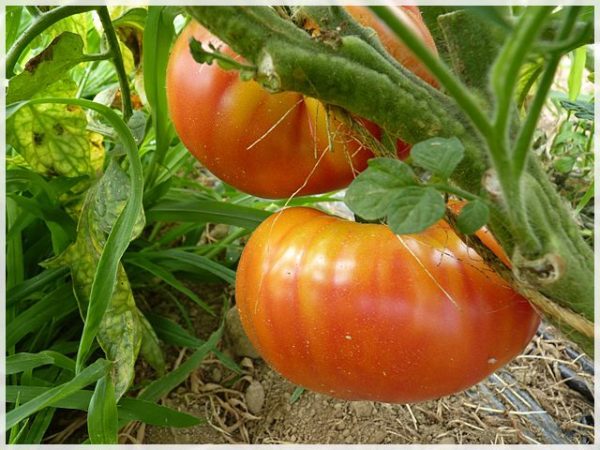
The fruits of a plant that have reached technical maturity are distinguished by a light green hue, which is gradually replaced by yellow. The onset of biological maturity is easily noticeable when the whole tomato becomes golden, with a small splash of red. Because of this, the fruits are mostly yellow-orange.
In shape, the tomatoes are oblong-rounded, containing many small chambers with seeds inside. This, together with thick outer walls, makes the fruits very fleshy, which is ideal for making salads and juices.
The fruits have a sweet taste. At the same time, even after ripening, they do not have the usual sourness, because of which they do not give the dishes a salty taste characteristic of ordinary tomatoes. Due to the sweetness and the almost complete absence of red pigment, these tomatoes are an ideal treat for children and people prone to allergies.
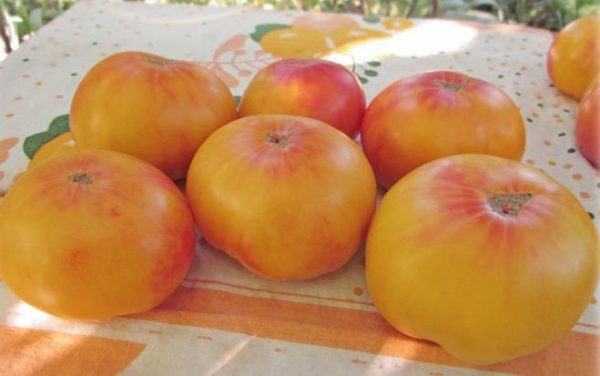
Tomato cultivation
The first sprouts should appear 55–65 days before planting in open ground, so the seeds are laid in cups in late February, early March.It is important that the containers are convenient for seedling extraction. Moreover, the plants have a very delicate root system and stem, because of which they cannot be pulled or dug up. Vessels that break easily or peat cups are considered ideal.
Seeds are laid in moist soil to a depth of 1 cm, after which the containers are put on a tray and covered with cling film or glass. The box is placed in a warm, dark place, with a temperature not exceeding + 280C. The first sprouts should appear after 4-6 days, after which they immediately remove the protective screen. This is necessary so that the seedlings do not begin to increase the length of the stem, but evenly develop its strength, as well as the root system.
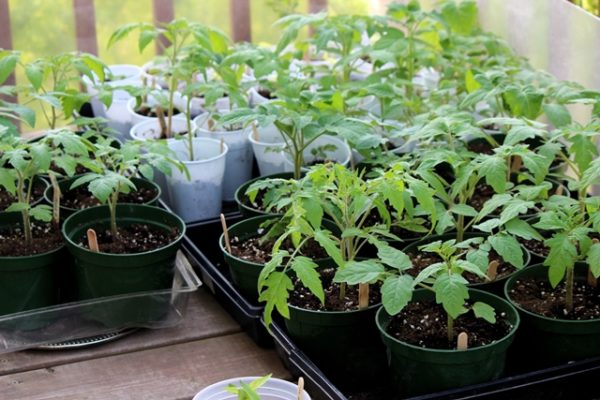
When the seedlings are going to be transferred to the open ground, then it must be hardened 14 days before. First, it is taken out into the street at the warmest time of the day for 1 hour, in the following days, gradually increasing the period of being in the fresh air. This will prepare the plant for more severe external conditions.
When the seedlings are ready, and the external temperature does not fall below +130 C, then sprouts can be planted. For this, 1 square. m form 3 holes, 3-4 cm deeper than the walls of the glass. At the bottom lay a hydrogel or a layer of humus. If seedlings were bred in peat containers, then additional layers are not required.
Plants are placed in prepared wells with the ground for seedlings. It is important to do this so as not to damage the root system. After that, the soil from the cups is sprinkled with surrounding soil in order to maximize the preservation of nutrients near the plant.
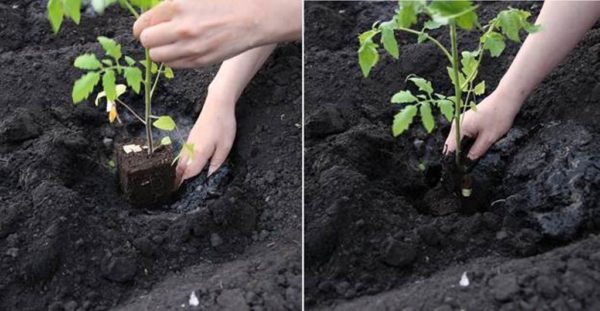
Tomato Care
After the plant hit the ground, you need to make sure that it has enough moisture. In greenhouse conditions, they are watered once every 3-5 days, due to the fact that water is lost only by evaporation, without going into the deep layers of the soil. For seedlings that fall into the open ground, more frequent watering is required, especially if there is a salt, rocky or sandy pillow under the humus.
When the tomato grows to 40–50 cm, it needs to be tied up so that with an increase in the volume of the fruit, the stem does not break. If this is not done, then gradually the tomatoes will deflect the plant to the ground, forcing them to expend nutrients to grow the stem. Or the fruits will be so heavy that the stalk can detach from the stem of the plant.
Tie the plant every 10-20 cm, with wide cloth stripes. At the same time, they make sure that the vegetation of the stem is not disturbed, otherwise it may begin to rot in this place. When large fruits appear, so that they are fully ripe, they also tie up the tomato brushes, partially relieving the load from them.

Plant nutrition
Even if the soil of the greenhouses has a good composition, tomatoes need to be fertilized 2-3 weeks after transplantation.For this, factory fertilizers are diluted in water, which make up the basic elements needed by plants.
The composition of fertilizers per 1 liter of water (enough for 1 plant):
- nitrogen-containing, 2.5 g;
- phosphoric, 4 g .;
- potash 1.5 g
A second top dressing is required upon the onset of a period of mass flowering. For her you will need:
- 1 liter of water;
- 50 ml of bird droppings;
- 50 ml mullein;
- 1.5 g of potassium sulfate.
All fertilizers are applied next to the stem so that drops do not fall on it. This is dangerous, because in air substances of organic origin are an ideal environment for the emergence of colonies of microorganisms.
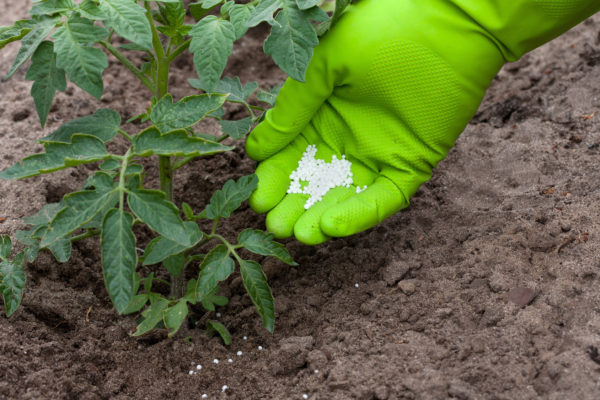
Reviews of gardeners
Nina Alexandrovna, 71 years old. Moscow region:
“This year I discovered Georgia - good and juicy fruits. I especially liked the juices, and the salads needed to be salted a little more than usual - otherwise the family complains that some taste is different. In general, I am satisfied with the tomatoes, I will continue to plant them. ”
Petr Nikolaevich, 54 years old. Volgograd region:
“I’ve been divorcing Georgia for about 5 years, and there were problems only in the first year, when I didn’t fertilize the soil properly. Plants began to fade, which affected the amount of harvest. But by the next year I prepared, and took good care of the tomatoes, so they gave so many tomatoes that they had to give out to relatives. Now I plant a much smaller amount, knowing that the family has enough tomatoes. ”
Tomato Georgia is the perfect solution for people who are allergic to red tomatoes. At the same time, the plant has a pleasant feature, it bears fruit well in the greenhouse, as long as there are favorable conditions. This has a positive effect on the amount of harvest.




 Low-growing tomatoes, without pinching: 5 of the most delicious varieties
Low-growing tomatoes, without pinching: 5 of the most delicious varieties Why tomato seedlings grow poorly
Why tomato seedlings grow poorly We grow a tomato in a shell
We grow a tomato in a shell Growing tomatoes without watering according to the method of Kazarin
Growing tomatoes without watering according to the method of Kazarin